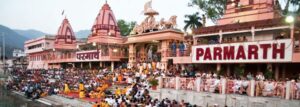
The town of Rishikesh in Dehradun district lies at the foothills of the Himalayas of the Garhwal region. It is the gateway to the upper Garhwal region and the starting point for the Char Dham pilgrimage (Gangotri, Yamunotri, Badrinath and Kedarnath) and an ideal destination not only for pilgrims but also for the people who are interested in adventure, meditation, yoga and other aspects of Hinduism.
Rishikesh is also a Gateway to the World Heritage site Valley of Flowers National Park – The 8th Wonder of the World.
Rishikesh is situated 24 kms upstream from Haridwar, at the confluence of the Chandrabhaga and Ganga and surrounded by scenic beauty of the hills on three sides. The whole place is considered to be sacred as it is believed that meditation at this place leads to attainment of salvation. There are many temples-some ancient, some new along the river Ganges. The River side is dotted by the ashrams of Sadhus and Sages.
The whole area (Garhwal) was famous as Kedarkhand in the past as mentioned in the Skanda Purana. As per the Skanda Purana the area is named as Kubjamrak because here lord Vishnu appeared to Raibhya Rishi under a mango tree. Raibhya Rishi selected the place for his long penance (Tapasya or austerity) Lord Vishnu was pleased by his act and appeared to the sage as a “Hrishikesh.” The word is combination of two word Hrishik and esh. Hrishik means senses and esh means god or master. It means god of senses. In Skanda Purana it is mentioned that the Lord Vishnu blessed Raibhya Rishi and gave him this divine message: “while you have performed supreme tapasya (austerities) by controlling your senses, let the place be recognized as Hrishikesha (Lord Hrishikesha, master of all senses).
The place is also mentioned as place where God Vishnu defeated the mighty demon Madhu. As per the Ramayana Lord Ram made hard penance for killing mighty demon Ravana. Lakshmana (Brother of Lord Rama) crossed the river by Jute Bridge which is known as Lakshman Jhula. The Jute Bridge was replaced by Iron suspension bridge in 1889. The ‘Kedarkhand’ of Skanda Purana, also mentions the existence of Indrakund at this very point. Legends also mention that the Lord Agni (God of fire) made penance for Lord Shiva.
According to the legends Lord Shiva consumed poison (Halahal) which was obtained during sea churning (Samudra Manthan) along with the Nectar (Amrit) here. The place is now known as Nilkanth Mahadev Temple. Thousands of tourists visit this temple during Shivratri and Kanwar Mela.
The sacred river Ganges flows through Rishikesh. Here the river leaves the Shivalik Hills in the Himalayas and flows into the plains of northern India. Several temples, ancient and new, are along the banks of the Ganges in Rishikesh. Shatrughna Mandir, Bharat Mandir, Lakshman Mandir are the ancient temples established by Adi Shankaracharya. Shatrughna Temple is near Ram Jhula and Lakshman Mandir is near Lakshman Jhula.
Other Attractions
Parmarth Niketan : Parmarth Niketan Ashram is located in the Swarg Ashram area. The Ashram has so many rooms for devotees as well as tourist. Ashram has many religious statues inside. Parmarth Niketan is also the host for the International Yoga Festival every year. Ashram is popular among the tourist for Yoga.
Sivananda Ashram : Sivananda Ashram is also known as Divine Life Society. It is located near Ram Jhula. Sivanada Ashram was established by Swami Sivananda. Swami Sivanada lived here for more than 30 years. There are several activities performed by the Ashram such as Yoga Meditation and hospital. Sivananda Ashram has rooms for the guest. Ashram has Meditation hall, Yoga Hall & Music Hall. Sivananda Ashram is one of the most popular ashrams in Rishikesh.
Source:
http://www.rishikeshtourism.in/
https://haridwarrishikeshtourism.com/rishikesh.html
https://en.wikipedia.org/wiki/Rishikesh


